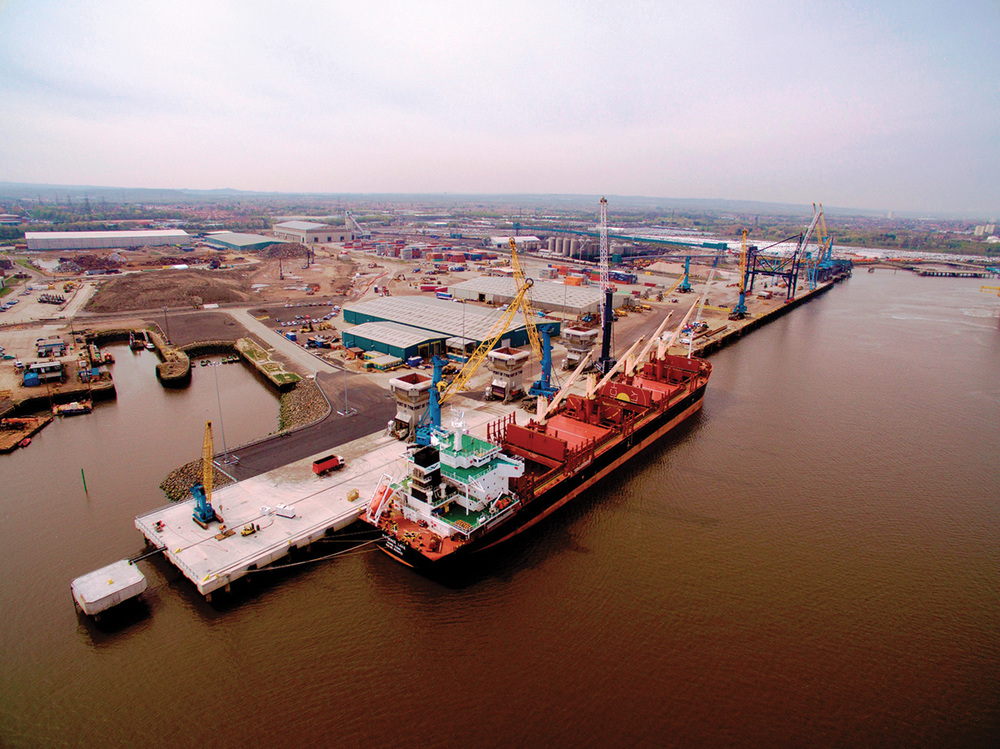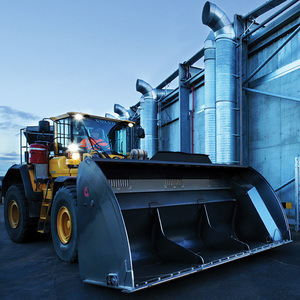Doubling Down







PHOTO: Associated British Ports
September 8, 2016
BY Tim Portz
In 2010, the United Kingdom imported just over a half million metric tons of wood pellets. Drax Power Station, the kingdom’s largest coal-fired power plant, had just begun burning wood pellets in one of the world’s largest decarbonization efforts ever undertaken. With virtually no domestic wood pellet industry to speak of, the country’s vast network of ports would be called upon to receive imports of wood pellets to keep an uninterrupted flow headed for Drax.
Among the first ports to invest in pellet handling infrastructure was the Port of Tyne. “We spent most of 2010 getting ourselves up and running and were able to receive our first pellets in September of that year,” says Steven Harrison, chief operating officer at Port of Tyne. Those volumes were the first that stemmed from the port’s agreement with Drax, signed in November of 2009, to handle up to 1.4 million tons of wood pellets per year. Once the contract was signed, the port began work on the necessary infrastructure to receive, store and efficiently load wood pellets into waiting trains. That September, the port was ready, using existing cranes to offload pellets from a vessel into custom hoppers designed to control dust at the quay and finally into flat storage inside a covered warehouse. The system was relatively simple but effective and established the port as the country’s first real player in industrial wood pellet receiving and handling. Other ports weren’t far behind.
By 2012 and 2013, ports on the country’s eastern seaboard were making their own investments as Drax sought to diversify its supply chain partners. About 150 miles south of the Port of Tyne, pellet infrastructure investments were happening at several of the ports along the Humber estuary including Hull, Immingham and Grimsby. In April of 2013, Graham Construction was awarded a contract to build the Immingham Renewable Fuels Terminal, while just inland, Spencer Group was at work building silos and a rail loading terminal that would allow Hull to handle nearly 1 million tons of pellets per year.
The year of 2014 saw pellet imports to the United Kingdom swell to nearly 5 million and in 2015 that number rose to 6.5 million tons. The continued growth in imported pellet volumes is almost certain to continue as a conversion project at 420 MW Lynemouth Power and MGT Teeside Ltd.’s 299 MW combined-heat-and-power project have both been approved for Contract for Difference contracts from the British government. Together, the growth of existing demand at Drax and the promise of these new volumes has catalyzed another wave of investment within the country’s port complex. These most recent projects make it clear that both contractors and port operators have learned a great deal since receiving their first shiploads of pellets and are driving those discoveries into new project designs.
Infrastructure Investment 2.0
In May, during its annual general meeting, the Port of Tyne announced that it had secured a contract with Lynemouth Power Ltd. to handle up to 1.8 million tons of pellets annually. This new contract was partially responsible for £25 million ($33 million) worth of infrastructure investment the port has made recently. The bulk of this investment was an extension of the Riverside Quay by 125 meters. “This is the single, biggest investment we have made since we built Europe's first purpose-built wood pellet facilities back in 2010, and it will significantly increase the port's capacity to handle increased volumes of cargoes. Extending the length of the quay will increase the berthing capacity by almost 20 percent, enabling up to four large cargo ships to berth simultaneously,” states Andrew Moffat, CEO of the Port of Tyne in a statement issued by the port earlier this year.
Advertisement
Advertisement
In addition to the quay extension, 75,000 tons of storage capacity in three concrete silos, enclosed conveyors and a rail loading silo are also being built. The Port of Tyne is contributing £13 million to this portion of the project with the remainder being contributed by LPL.
The silos, Harrison notes, tie into the port’s need to distinguish one load of pellets from another. “Once the material gets to a power station, they are less concerned with segregating individual cargoes, so they can afford to put the pellets into one homogenous pile,” Harrison says. “Whereas, we are very much trying to segregate shipments because we need to be able to trace pellets, not only back to the pellet mill that produced them, but also to the forests where the fiber came from. This approach allows for better segregation of cargoes.”
At Hull and Immingham, Associated British Ports has already invested £130 million in wood pellet handling infrastructure. Late last year, an additional £4 million was invested in a state-of-the-art bulk storage warehouse. The facility, designed to handle and store dry bulk cargo, is loaded with design features to minimize the risk of fire and explosion, including an incipient aspirating fire detection system, internal LED lighting, an expanding foam fire suppression system, a smoke extraction system, and an internal and external mist/air system to control fugitive dust.
Advertisement
Advertisement
Most recently, a new player has emerged within Britain’s port complex, with Peel Ports announcing that it had dispatched its 400th rail shipment of wood pellets to Drax. The milestone was reached just seven months after opening the first phase of a biomass terminal that earlier releases from the port valued at £100 million.
Graham Construction was awarded the contract to construct the facility, making the company arguably the largest constructor of wood pellet handling and storage facilities worldwide. “This project builds on the experience we have gained from building similar facilities on the east coast of England,” states Leo Martin, executive director at Graham Construction in a release. “We will be designing and building a state-of-the-art plant which will employ industry-leading technologies to ensure that the facility can be safely operated and maintained.”
There can be no doubt that pellet volumes are a boon to the country’s busy ports. Harrison offers that pellets have grown to represent a significant percentage of the port’s dry bulk business and this year pellets will represent over 50 percent of Tyne’s dry bulk volume. There is another side to that same coin, however. Long before wood pellets were identified as a practical means to meet the country’s decarbonization goals, these same ports handled coal imports.
“With the U.K.’s energy policy shifting away from the reliance upon fossil fuels, we predicted that coal volumes would be gradually replaced by wood pellets," Harrison says. "Accordingly, coal reduced from 3.6 million metric tons in 2012 to 1.4 million metric tons in 2015.”
Viewed in that way, the innovation and investment in pellet handling infrastructure within Britain was vital if the ports were to continue to meet their financial goals, as the country’s intention to turn away from coal-derived power was clear. For Harrison and his colleagues at Port of Tyne, the transition was abrupt. “The rate of the reduction in coal volumes has happened faster than anyone anticipated, and we might yet see more coal handled as the U.K.’s energy supply continues to move toward alternative sources of power generation.”
Author: Tim Portz
Executive Editor, Pellet Mill Magazine
701-738-4969
tportz@bbiinternational.com
Upcoming Events





